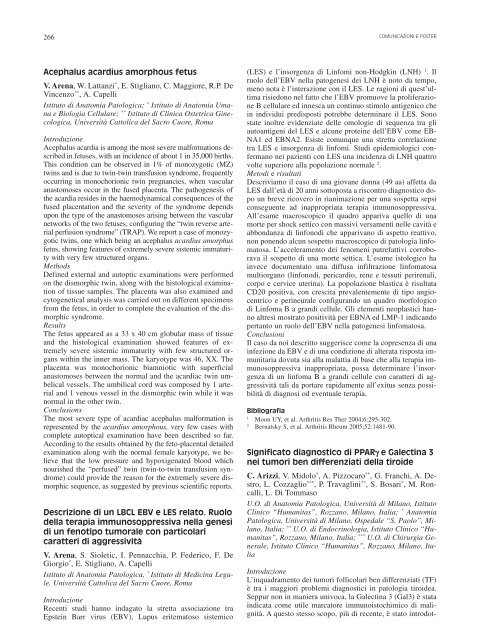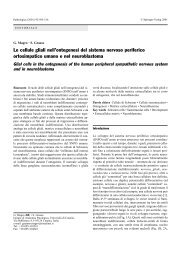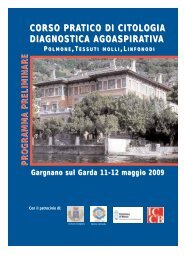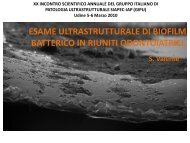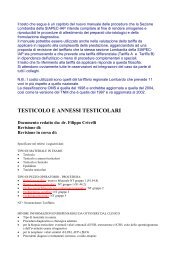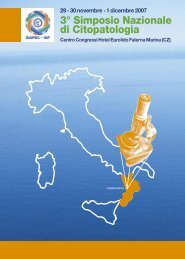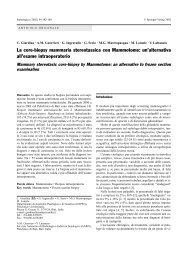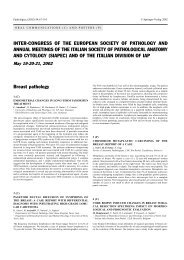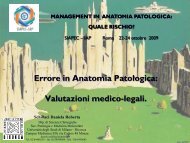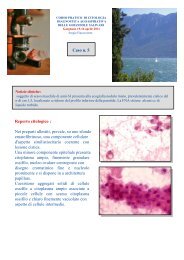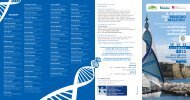pag. 216-318 - Siapec
pag. 216-318 - Siapec
pag. 216-318 - Siapec
Create successful ePaper yourself
Turn your PDF publications into a flip-book with our unique Google optimized e-Paper software.
266<br />
COMUNICAZIONI E POSTER<br />
Acephalus acardius amorphous fetus<br />
V. Arena, W. Lattanzi * , E. Stigliano, C. Maggiore, R.P. De<br />
Vincenzo ** , A. Capelli<br />
Istituto di Anatomia Patologica; * Istituto di Anatomia Umana<br />
e Biologia Cellulare; ** Istituto di Clinica Ostetrica Ginecologica,<br />
Università Cattolica del Sacro Cuore, Roma<br />
Introduzione<br />
Acephalus acardia is among the most severe malformations described<br />
in fetuses, with an incidence of about 1 in 35,000 births.<br />
This condition can be observed in 1% of monozygotic (MZ)<br />
twins and is due to twin-twin transfusion syndrome, frequently<br />
occurring in monochorionic twin pregnancies, when vascular<br />
anastomoses occur in the fused placenta. The pathogenesis of<br />
the acardia resides in the haemodynamical consequences of the<br />
fused placentation and the severity of the syndrome depends<br />
upon the type of the anastomoses arising between the vascular<br />
networks of the two fetuses, configuring the “twin reverse arterial<br />
perfusion syndrome” (TRAP). We report a case of monozygotic<br />
twins, one which being an acephalus acardius amorphus<br />
fetus, showing features of extremely severe sistemic immaturity<br />
with very few structured organs.<br />
Methods<br />
Defined external and autoptic examinations were performed<br />
on the dismorphic twin, along with the histological examination<br />
of tissue samples. The placenta was also examined and<br />
cytogenetical analysis was carried out on different specimens<br />
from the fetus, in order to complete the evaluation of the dismorphic<br />
syndrome.<br />
Results<br />
The fetus appeared as a 33 x 40 cm globular mass of tissue<br />
and the histological examination showed features of extremely<br />
severe sistemic immaturity with few structured organs<br />
within the inner mass. The karyotype was 46, XX. The<br />
placenta was monochorionic biamniotic with superficial<br />
anastomoses between the normal and the acardiac twin umbelical<br />
vessels. The umbilical cord was composed by 1 arterial<br />
and 1 venous vessel in the dismorphic twin while it was<br />
normal in the other twin.<br />
Conclusions<br />
The most severe type of acardiac acephalus malformation is<br />
represented by the acardius amorphous, very few cases with<br />
complete autoptical examination have been described so far.<br />
According to the results obtained by the feto-placental detailed<br />
examination along with the normal female karyotype, we believe<br />
that the low pressure and hypoxigenated blood which<br />
nourished the “perfused” twin (twin-to-twin transfusion syndrome)<br />
could provide the reason for the extremely severe dismorphic<br />
sequence, as suggested by previous scientific reports.<br />
Descrizione di un LBCL EBV e LES relato. Ruolo<br />
della terapia immunosoppressiva nella genesi<br />
di un fenotipo tumorale con particolari<br />
caratteri di aggressività<br />
V. Arena, S. Sioletic, I. Pennacchia, P. Federico, F. De<br />
Giorgio * , E. Stigliano, A. Capelli<br />
Istituto di Anatomia Patologica, * Istituto di Medicina Legale,<br />
Università Cattolica del Sacro Cuore, Roma<br />
Introduzione<br />
Recenti studi hanno indagato la stretta associazione tra<br />
Epstein Barr virus (EBV), Lupus eritematoso sistemico<br />
(LES) e l’insorgenza di Linfomi non-Hodgkin (LNH) 1 . Il<br />
ruolo dell’EBV nella patogenesi dei LNH è noto da tempo,<br />
meno nota è l’interazione con il LES. Le ragioni di quest’ultima<br />
risiedono nel fatto che l’EBV promuove la proliferazione<br />
B cellulare ed innesca un continuo stimolo antigenico che<br />
in individui predisposti potrebbe determinare il LES. Sono<br />
state inoltre evidenziate delle omologie di sequenza tra gli<br />
autoantigeni del LES e alcune proteine dell’EBV come EB-<br />
NA1 ed EBNA2. Esiste comunque una stretta correlazione<br />
tra LES e insorgenza di linfomi. Studi epidemiologici confermano<br />
nei pazienti con LES una incidenza di LNH quattro<br />
volte superiore alla popolazione normale 2 .<br />
Metodi e risultati<br />
Descriviamo il caso di una giovane donna (49 aa) affetta da<br />
LES dall’età di 20 anni sottoposta a riscontro diagnostico dopo<br />
un breve ricovero in rianimazione per una sospetta sepsi<br />
conseguente ad inappropriata terapia immunosoppressiva.<br />
All’esame macroscopico il quadro appariva quello di una<br />
morte per shock settico con massivi versamenti nelle cavità e<br />
abbondanza di linfonodi che apparivano di aspetto reattivo,<br />
non ponendo alcun sospetto macroscopico di patologia linfomatosa.<br />
L’acceleramento dei fenomeni putrefattivi corroborava<br />
il sospetto di una morte settica. L’esame istologico ha<br />
invece documentato una diffusa infiltrazione linfomatosa<br />
multiorgano (linfonodi, pericardio, rene e tessuti perirenali,<br />
corpo e cervice uterina). La popolazione blastica è risultata<br />
CD20 positiva, con crescita prevalentemente di tipo angiocentrico<br />
e perineurale configurando un quadro morfologico<br />
di Linfoma B a grandi cellule. Gli elementi neoplastici hanno<br />
altresì mostrato positività per EBNA ed LMP-1 indicando<br />
pertanto un ruolo dell’EBV nella patogenesi linfomatosa.<br />
Conclusioni<br />
Il caso da noi descritto suggerisce come la copresenza di una<br />
infezione da EBV e di una condizione di alterata risposta immunitaria<br />
dovuta sia alla malattia di base che alla terapia immunosoppressiva<br />
inappropriata, possa determinare l’insorgenza<br />
di un linfoma B a grandi cellule con caratteri di aggressività<br />
tali da portare rapidamente all’exitus senza possibilità<br />
di diagnosi od eventuale terapia.<br />
Bibliografia<br />
1<br />
Moon UY, et al. Arthritis Res Ther 2004;6:295-302.<br />
2<br />
Bernatsky S, et al. Arthritis Rheum 2005;52:1481-90.<br />
Significato diagnostico di PPARγ e Galectina 3<br />
nei tumori ben differenziati della tiroide<br />
C. Arizzi, V. Midolo * , A. Pizzocaro ** , G. Franchi, A. Destro,<br />
L. Cozzaglio *** , P. Travaglini ** , S. Bosari * , M. Roncalli,<br />
L. Di Tommaso<br />
U.O. di Anatomia Patologica, Università di Milano, Istituto<br />
Clinico “Humanitas”, Rozzano, Milano, Italia; * Anatomia<br />
Patologica, Università di Milano, Ospedale “S. Paolo”, Milano,<br />
Italia; ** U.O. di Endocrinologia, Istituto Clinico “Humanitas”,<br />
Rozzano, Milano, Italia; *** U.O. di Chirurgia Generale,<br />
Istituto Clinico “Humanitas”, Rozzano, Milano, Italia<br />
Introduzione<br />
L’inquadramento dei tumori follicolari ben differenziati (TF)<br />
è tra i maggiori problemi diagnostici in patologia tiroidea.<br />
Seppur non in maniera univoca, la Galectina 3 (Gal3) è stata<br />
indicata come utile marcatore immunoistochimico di malignità.<br />
A questo stesso scopo, più di recente, è stato introdot-


